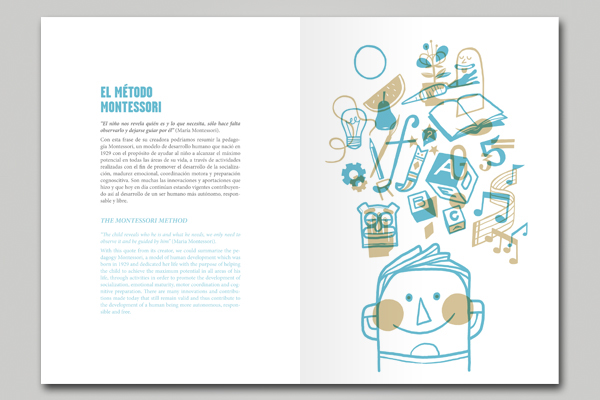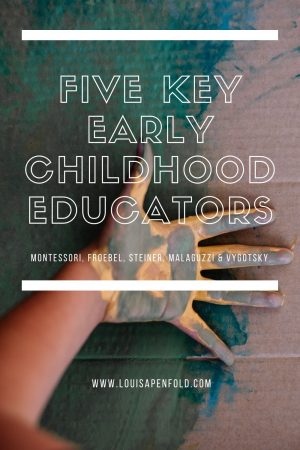This post is especially for parents who are trying to find the right pre-school for their child.
If you are on the hunt already, you may have noticed that many kindergartens advertise as being ‘Steiner,’ ‘Reggio Emilia,’ ‘Froebel’ or ‘Montessori’ inspired.
However, unless you have an early childhood qualification yourself, these terms can be quite confusing!
In this post, I introduce five key people who have had a huge influence on early childhood education: Froebel, Montessori, Steiner, Malaguzzi and Vygotsky.
I talk about who these people are and the contributions they have made to kindergarten teaching around the world.

Froebel
Friedrich Froebel is credited as being the founder of the kindergarten. He did this back in 1700s Germany as he believed that young children needed their own place to learn in that was separate to adults.
Froebel believed that play was an integral in children’s active learning. He once famously said:
“Play is the highest expression of human development in childhood, for it alone is the free expression of what is in a child’s soul.”
Froebel believed that children were naturally creative beings and that play allowed for the ‘whole child’ to be educated. While play-based learning is a central part of many pre-schools today, this was quite a radical concept for Froebel’s time!
Froebel created an activity-based approach to kindergarten curriculum that included physical activities, the arts, nature play and structured learning experiences with manipulative materials that he called ‘Gifts.’
My recent blog post on Froebel’s Gifts explains what these are in more detail.
These Gifts allowed children to learn through hands-on play with physical things including blocks, balls and clay.
Montessori
The Montessori teaching method was created by Maria Montessori in the early 1900s in Italy. Maria originally studied medicine before starting her work on children’s education. Influenced by the work of Friedrich Froebel and the Swiss educator Pestalozzi, Maria initially worked with disadvantaged and disabled children living in slums in Rome. Much of the Montessori method was initially influenced by these experiences. As a result, the approach has a strong focus on children’s multi-sensory learning through play with materials.
In Montessori pre-schools, children are encouraged to learn at their own pace. Classes are often arranged into three-year age groups (0-3, 3-6, 6-9 and 9-12 years of age) with older children acting as mentors for younger students. It is interesting to note that in traditional Montessori kindergartens, the same teacher often stays with a group of students for this three-year period. This allows for a strong relationship to be formed between teacher and students.
The Montessori method differs from Steiner and Reggio Emilia approaches through its detailed, planned and structured learning environments.
While Montessori kindergartens have spread across the world, the approach has also been critiqued by American progressive education
While Maria Montessori has contributed a lot to early childhood education, it is interesting to note that she was a Nazi collaborator and that the Montessori method was Mussolini’s preferred educational approach.
Following the war, Maria spent many years advocating for peace education, especially in India.
Steiner
Rudolf Steiner (1861-1925) created the ‘Waldorf’ approach to education. His first school opened in Stuttgart in 1919. Steiner believed that art, science and spirituality needed to be brought together
Steiner’s education approach to education was inspired by Modernist artists such as Piet Mondrian, Wassily Kandinsky and Joseph Beuys. His pedagogical approach also influenced the education practices of
Many present-day Steiner schools design their curriculum using ‘project-based learning’ activities. This means that children get to determine the content, method and mode of assessment of learning activities.
Imaginative play, visual art and practical tasks including cooking, gardening and cleaning are all integrated into the day-to-day activities of Steiner schools. Waldorf schools often go all the way to high school. They are therefore not only kindergartens.
Traditional Steiner preschools are often built and furnished using plain wood and natural materials. These natural materials and colours are in contrast to the interior décor of many contemporary kindergartens that feature plastic toys and primary coloured furnishings. Steiner school’s use of natural materials is done to reinforce children’s relationship with nature.
Waldorf schools have made headlines in recent years in relation to Steiner’s philosophy on vaccination. He believed that illness was rooted in problems from previous lives and that people could resolve this by generating positive karma in their current life. From this perspective, vaccination gets in the way of this karmic energy. As a result, some Steiner schools (not all) have caused controversy over their relaxed approach to child vaccination in both the United Kingdom and America.
Many kindergartens draw on aspects of Waldorf education and are therefore ‘Steiner-inspired’ instead of being traditional Steiner schools.
Malaguzzi
Loris Malaguzzi founded the Reggio Emilia early childhood philosophy in Italy following the Second World War. Malaguzzi lived in the small town of Reggio Emilia, located just north of Bologna. The educational approach is named after this region.
Malaguzzi’s educational approach was named after this town. Following Mussolini’s Fascist dictatorship in Italy, Malaguzzi and a group of young women set about setting up a series of pre-school in the region.
The philosophy for these schools was based on the understanding that children have the human rights to play an active role in democratic communities.
Educators using the Reggio Emilia approach often emphasise the important role of relationships in learning. For example, relationships between children, their families, teachers, the physical environment and wider communities.
Children are also valued as capable and active members of the community. This ‘Image of the Child’ means that children’s ideas and opinions need to be made visible and responded to by adults.
Reggio Emilia educators also often evaluate learning using a reflective process called ‘pedagogical documentation.’ To do this, teachers record children’s learning using photos, videos and written notes to reflect on children’s learning. From these discussions, teachers then make plans for what following activities can be done that extend children’s interests and curiosities. This is process referred to as a ‘child-led curriculum.’
The Reggio Emilia approach also emphasises the importance of the physical environment as a ‘third teacher’ in children’s learning. Similar to the Montessori approach, Reggio Emilia educators often spend a lot of time planning and selecting materials and physical resource for children to play with.
However, unlike Montessori, the Reggio Emilia philosophy also encourages educators to collect and use recycled materials in creative activities.
You can read about my visit to the Loris Malaguzzi Centre in Reggio Emilia here:
Creativity and children’s art studios in Reggio Emilia
Vygotsky
Lev Vygostsky was a Russian child psychologist who wrote extensively on children’s cognitive development in social learning settings. He is famous for consisting two key ideas on children’s learning: Scaffolding and the Zone of Proximal Development (ZPD).
The ZPD is the distance between what a learner can do without assistance and what they can do with the assistance of others. Scaffolding can be understood as a process in which a more knowledgeable person helps a child undertake an activity that they would normally not be able to do independently.
Like the ‘scaffolding’ on a building, this assistance supports children’s learning by helping them to eventually undertake activities autonomously. You may hear kindergarten teachers use the terms ‘scaffolding’ and ‘Zone of Proximal Development’ in relation to children’s learning at preschool.
You can read about Vygotsky’s ideas on creativity in children’s learning here:
Vygotsky on collective creativity
Vygotsky however his work has been momentously influential on early childhood education, particularly in relation to children’s learning in social contexts.
In conclusion…
These are just five people who have had a huge influenced
For example, a kindergarten teacher may use some ideas from Steiner and combine this with the Reggio Emilia approach. However, specialist Steiner, Froebel and Montessori schools do exist. For example, there are four Froebel preschools in Australia and numerous private Steiner schools in England.
If you are wondering which education approach is ‘the best,’ I personally would be looking for a good kindergarten teacher who is intelligent, creative, patient and kind. This is opposed to selecting a pre-school based on a particular education model.
In my opinion, a good educator will combine and tailor different theories and practices based on children’s unique needs and interests. They will also keep up to date with new research, ideas and practices and experiment with these in the classroom.
I hope this post has helped to de-mystify parts of pre-school teaching!
What are the most important to you when looking for a kindergarten?
Tell me below!
Related Posts
3 tips for scaffolding children’s learning with materials
Using suggestions to support children’s creative learning3 books on documenting children’s learning
